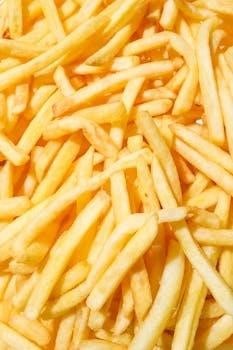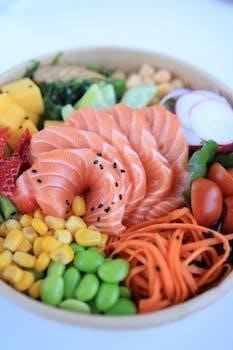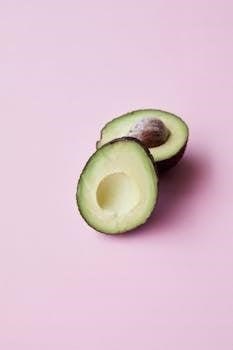Understanding the Fast 800 Keto Meal Plan
The Fast 800 Keto plan integrates principles of a ketogenic diet with calorie restriction, often aiming for 800 daily calories․ This approach combines low-carb intake, high-fat consumption, and moderate protein, inducing ketosis․ The plan uses dietary changes for weight management and health benefits․
What is the Fast 800 Keto?
The Fast 800 Keto is a dietary approach that combines the principles of the ketogenic diet with a very low-calorie intake, typically around 800 calories per day․ This plan is designed to induce a state of ketosis, where the body primarily burns fat for fuel instead of carbohydrates․ It is a more intensive version of the Fast 800 diet, which usually allows slightly higher caloric intake․ The Fast 800 Keto emphasizes a low-carbohydrate, high-fat intake, with a moderate amount of protein․ This combination aims to promote rapid weight loss and improve metabolic health, specifically targeting visceral fat․ The diet often incorporates Mediterranean-style eating principles, focusing on whole foods․ It is crucial to approach such a restrictive diet with caution and under medical supervision, especially for individuals with pre-existing health conditions․ This plan’s intensity requires careful consideration of nutrient intake and potential health risks, but it is aimed at quick and effective results․
The Core Principles of the Plan
The core principles of the Fast 800 Keto revolve around significantly reducing carbohydrate intake while increasing the consumption of healthy fats and maintaining a moderate protein level․ This dietary shift forces the body into a state of ketosis, where it begins to burn fat for energy instead of glucose․ Another fundamental aspect is the substantial calorie restriction, limiting daily intake to around 800 calories․ This low-calorie intake is designed to promote rapid weight loss․ The plan emphasizes nutrient-dense foods, focusing on whole, unprocessed options, often incorporating Mediterranean diet elements․ These foods include plenty of non-starchy vegetables, quality protein sources, and healthy fats from avocados, nuts, and olive oil․ The plan also includes intermittent fasting elements, which can be incorporated to further enhance the diet’s impact․ Monitoring macronutrient ratios is key, keeping carbs below 50 grams per day and maintaining a higher fat to protein ratio․
Calorie Restriction and Ketosis
The Fast 800 Keto plan utilizes a dual approach of significant calorie restriction and the induction of ketosis to facilitate rapid weight loss and improve metabolic health․ By limiting daily calorie intake to approximately 800, the body is forced to tap into its fat reserves for energy, accelerating the fat-burning process․ Simultaneously, the drastic reduction in carbohydrates, typically below 50 grams per day, depletes the body’s glycogen stores․ This depletion forces the liver to convert fat into ketones, which become the primary energy source in a metabolic state known as ketosis․ This combination of low calories and low carbs enhances the mobilization of fat from cells, making it available for energy․ The body starts to use fat as its main fuel source, leading to a more efficient fat burn․ This dual strategy is designed for quick, effective results, but it should be approached with caution and medical guidance, considering the potential health implications․

Key Aspects of the 800 Calorie Keto Diet
The 800 calorie keto diet requires careful nutritional planning to ensure adequate intake of essential nutrients․ It’s vital to consider potential health risks and seek guidance from healthcare professionals before beginning․
Nutritional Considerations
When following a very low-calorie ketogenic diet like the Fast 800 Keto, it’s crucial to prioritize nutrient-dense foods․ Limiting daily intake to 800 calories can easily lead to deficiencies if not carefully planned․ Focus on consuming adequate protein, aiming for over 50 grams daily, to preserve muscle mass․ Include healthy fats from sources like avocados, nuts, and olive oil, which are vital for ketosis and overall health․ Carbohydrates should be kept under 50 grams per day, primarily from non-starchy vegetables like leafy greens, broccoli, and Brussels sprouts․ Pay attention to micronutrients, ensuring sufficient intake of vitamins and minerals through a variety of whole foods․ Consider supplementing with a multivitamin if necessary, especially when restricting calories so drastically․ Hydration is also paramount․ Be mindful of potential electrolyte imbalances, which can occur during ketosis, and adjust your intake of sodium, potassium, and magnesium․ This careful planning is necessary to avoid nutritional deficiencies and ensure the diet is as safe and effective as possible․
Potential Health Risks
Adhering to an 800-calorie ketogenic diet comes with potential health risks that must be considered․ Such a significant calorie restriction can lead to nutritional deficiencies if not meticulously managed․ Common issues include electrolyte imbalances, which may cause fatigue, dizziness, and muscle cramps․ The body’s adaptation to ketosis may also result in “keto flu,” with symptoms such as headaches, nausea, and irritability․ Individuals with existing health conditions, such as diabetes or heart disease, should be particularly cautious, as this diet may exacerbate their conditions․ Those taking medications should also consult their healthcare provider, as the diet may interfere with drug efficacy․ Long-term adherence to a very low-calorie diet can result in muscle loss, gallstones, and potentially affect bone density․ It’s essential to monitor for any adverse symptoms and consult a healthcare professional before starting and during the diet to mitigate these risks․ The diet is not suitable for everyone and should be approached with caution and medical advice․

Importance of Medical Guidance
Seeking medical guidance is crucial before starting any drastic diet, particularly the Fast 800 Keto plan․ Consulting with a healthcare professional ensures that this diet is appropriate for your specific health needs and conditions․ A doctor can evaluate your medical history, current medications, and any underlying health issues that could be negatively impacted by a very low-calorie, ketogenic diet․ They can provide personalized advice and monitor your progress to prevent or address any health risks․ Medical professionals can assess for potential nutrient deficiencies and recommend appropriate supplementation․ Regular check-ups are important during the diet to monitor blood sugar levels, cholesterol, and other vital health markers․ Medical guidance helps tailor the plan to your individual needs, ensuring that it’s done safely and effectively․ They can also offer alternative approaches if needed․ A healthcare provider should be an integral part of the process, ensuring the diet is implemented safely;

Finding and Utilizing Meal Plans
Locating suitable meal plans for the Fast 800 Keto diet is essential for success․ Options include free PDF downloads, personalized services, and customizable plans to meet individual needs․ These resources help with meal planning and adherence․
Where to Find Free PDF Meal Plans
Numerous online resources offer free PDF meal plans for the Fast 800 Keto diet, catering to diverse dietary preferences and needs; Websites dedicated to health and wellness often feature downloadable plans, sometimes including recipes and nutritional breakdowns․ These PDF documents typically provide structured meal ideas for breakfast, lunch, and dinner, simplifying the initial planning process․ Blogs and forums centered on ketogenic and low-calorie diets also serve as valuable sources, with users sharing their own meal plans and experiences․ Additionally, some healthcare providers and nutritionists may offer free PDF meal plans on their websites or through newsletters․ When searching for these resources, using specific keywords like “Fast 800 Keto meal plan PDF” can yield targeted results․ It’s crucial to verify the credibility of the source and consider whether the plan aligns with individual health requirements and dietary restrictions․ Remember that while free PDF plans are convenient, they might not fully address unique needs or offer personalized support․ Therefore, they should be viewed as a starting point for an individual’s journey on the Fast 800 Keto diet․
Personalized Meal Planning Options
While free PDF meal plans offer a starting point, personalized meal planning provides a more tailored approach to the Fast 800 Keto diet․ Several online platforms and apps offer tools to create customized meal plans based on individual preferences, dietary restrictions, and specific goals․ These services often allow users to input their food allergies, favorite ingredients, and desired macronutrient ratios, generating meal options that align with their unique requirements․ Some platforms also consider factors like activity levels and medical conditions when creating plans․ Many of these personalized options come with a subscription fee, but they provide greater flexibility and support․ Additionally, consulting with a registered dietitian or nutritionist can lead to highly customized meal plans designed specifically for an individual’s health needs․ These professionals can offer guidance on portion sizes, nutrient timing, and potential modifications to the diet․ It’s important to explore various personalized options, considering both cost and level of customization, to find what best suits individual needs and preferences on the Fast 800 Keto diet․ This ensures a sustainable approach․
Customizing Meal Plans for Individual Needs
Adapting a generic Fast 800 Keto meal plan to fit individual needs is essential for long-term success․ Factors such as activity level, food preferences, and existing health conditions should influence meal choices․ Those with higher activity levels might need to adjust portion sizes or include additional protein․ Individuals with food sensitivities or allergies must modify plans to exclude problematic ingredients, finding suitable alternatives․ Pre-existing medical conditions, such as diabetes or heart issues, require careful consideration․ Consulting with a healthcare professional is vital to ensure the meal plan is safe and appropriate․ Furthermore, personal taste preferences should be accommodated to avoid diet fatigue․ This might involve swapping out specific vegetables or proteins for preferred options within the low-carb framework․ Customizing also entails adjusting meal timings to align with daily routines․ Flexible planning, such as allowing for occasional variations or swaps, can contribute to greater adherence to the diet․ By actively customizing, individuals can ensure the Fast 800 Keto plan is sustainable, enjoyable and effectively supports their health and weight management goals․

Sample Meal Ideas and Recipes
Exploring recipes involves low-carb, non-starchy options like leafy greens, and lean proteins․ Focus on incorporating healthy fats and ensure adequate protein intake․ A sample day might include eggs, chicken, and vegetables․
Low Carb and Non-Starchy Food Choices
When following the Fast 800 Keto plan, prioritizing low-carbohydrate and non-starchy foods is crucial for achieving and maintaining ketosis․ Focus on incorporating a variety of leafy green vegetables such as kale, spinach, Swiss chard, bok choy, lettuce, and radicchio․ Other excellent choices include non-starchy vegetables like Brussels sprouts, broccoli, and green beans․ These options are not only low in carbs but also rich in essential vitamins and minerals․ When selecting protein sources, opt for lean meats, poultry, and fish․ Fatty cuts of beef, chicken with the skin, and wild game can be included in moderation to increase fat intake․ Remember to minimize starchy vegetables and grains, and focus on those that will support your ketogenic and calorie-restricted goals․ This selection of low carb and non-starchy choices is foundational to the success of the Fast 800 Keto plan, promoting fat burning and weight loss․
Focus on Protein Intake
In the Fast 800 Keto meal plan, maintaining an adequate protein intake is crucial, particularly given the reduced calorie consumption․ Protein plays a vital role in preserving muscle mass while promoting fat loss, which is especially important during a low-calorie diet․ Aim for a protein intake above 50 grams per day, as suggested by some guidelines related to this plan, which helps with satiety and prevents muscle breakdown․ Including a good source of protein at every meal is advisable, such as eggs, lean meats, poultry, fish, and seafood․ While emphasizing protein, it’s important to balance with the high-fat and low-carb components of the keto diet․ Protein sources should be lean and of high quality to support overall health and well-being․ Sufficient protein intake will help keep you feeling full and satisfied while adhering to the calorie restrictions of the Fast 800 Keto plan․ Proper protein consumption is also important to maintain overall body function during this type of diet․
Example of a Daily Menu
A sample daily menu for the Fast 800 Keto plan might start with a breakfast of scrambled eggs with spinach and a small amount of cheese․ Lunch could consist of a salad with grilled chicken or fish, avocado, and a low-carb dressing․ Dinner might be a curry chicken dish with broccoli and green beans․ For snacks, options might include a small handful of almonds or a few slices of cheese․ This menu emphasizes high protein and healthy fats while keeping carbohydrates low to maintain ketosis․ It is essential to maintain portion control to stay within the 800-calorie limit․ Beverages should consist of water, unsweetened tea, or black coffee․ This daily menu is just an example and can be adjusted to individual preferences and dietary requirements․ Remember to focus on non-starchy vegetables, healthy protein sources, and fats that fit into a ketogenic diet to meet the objectives of the plan and dietary guidelines․